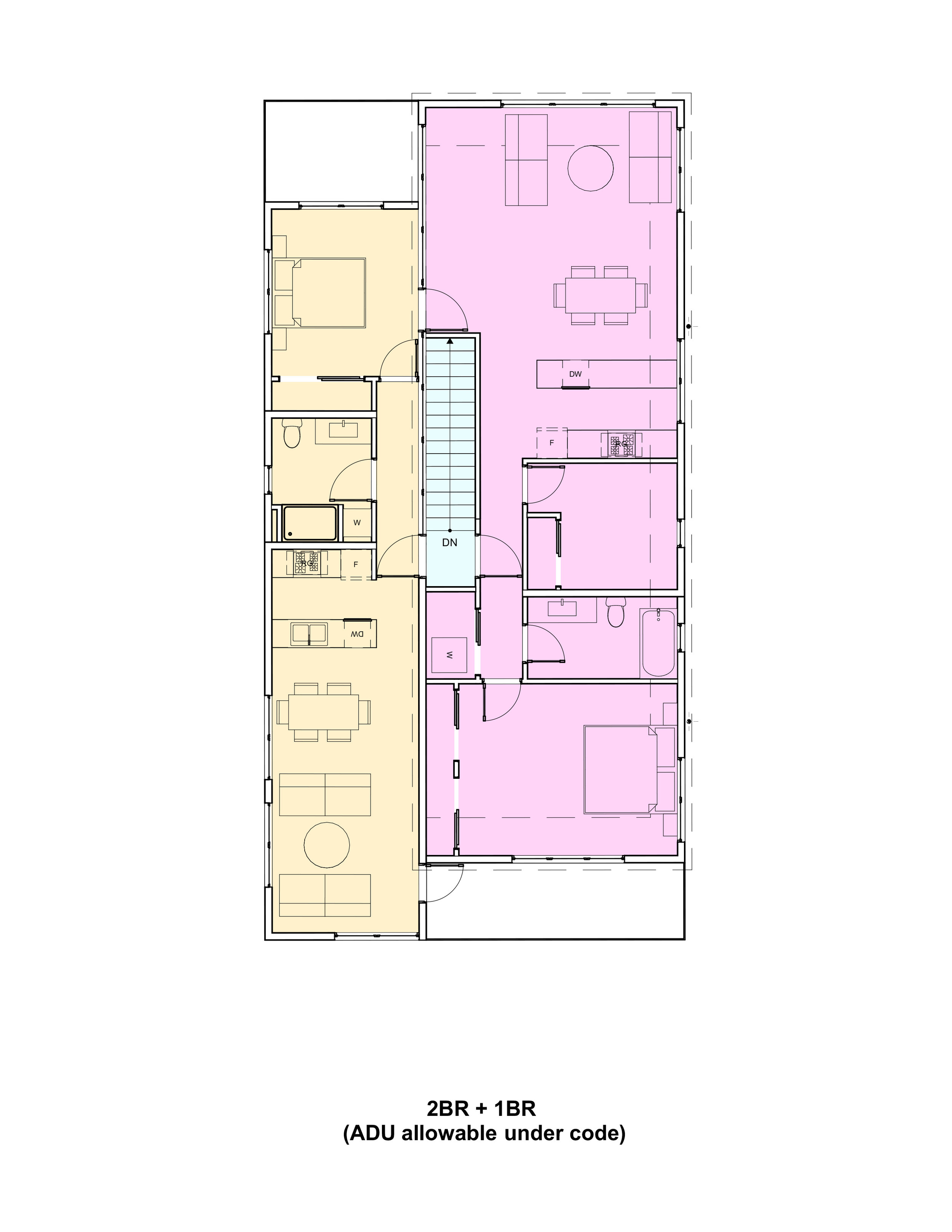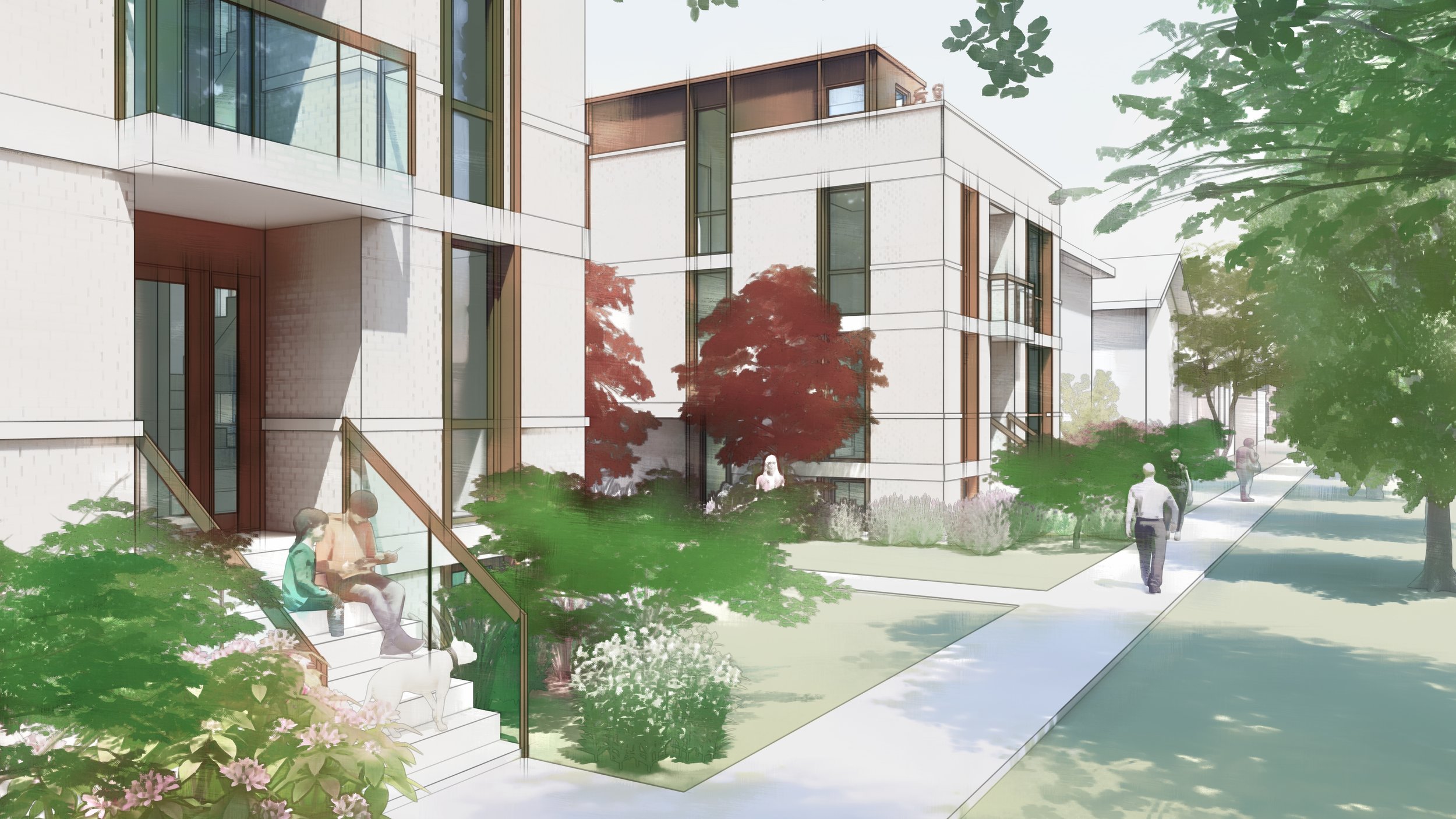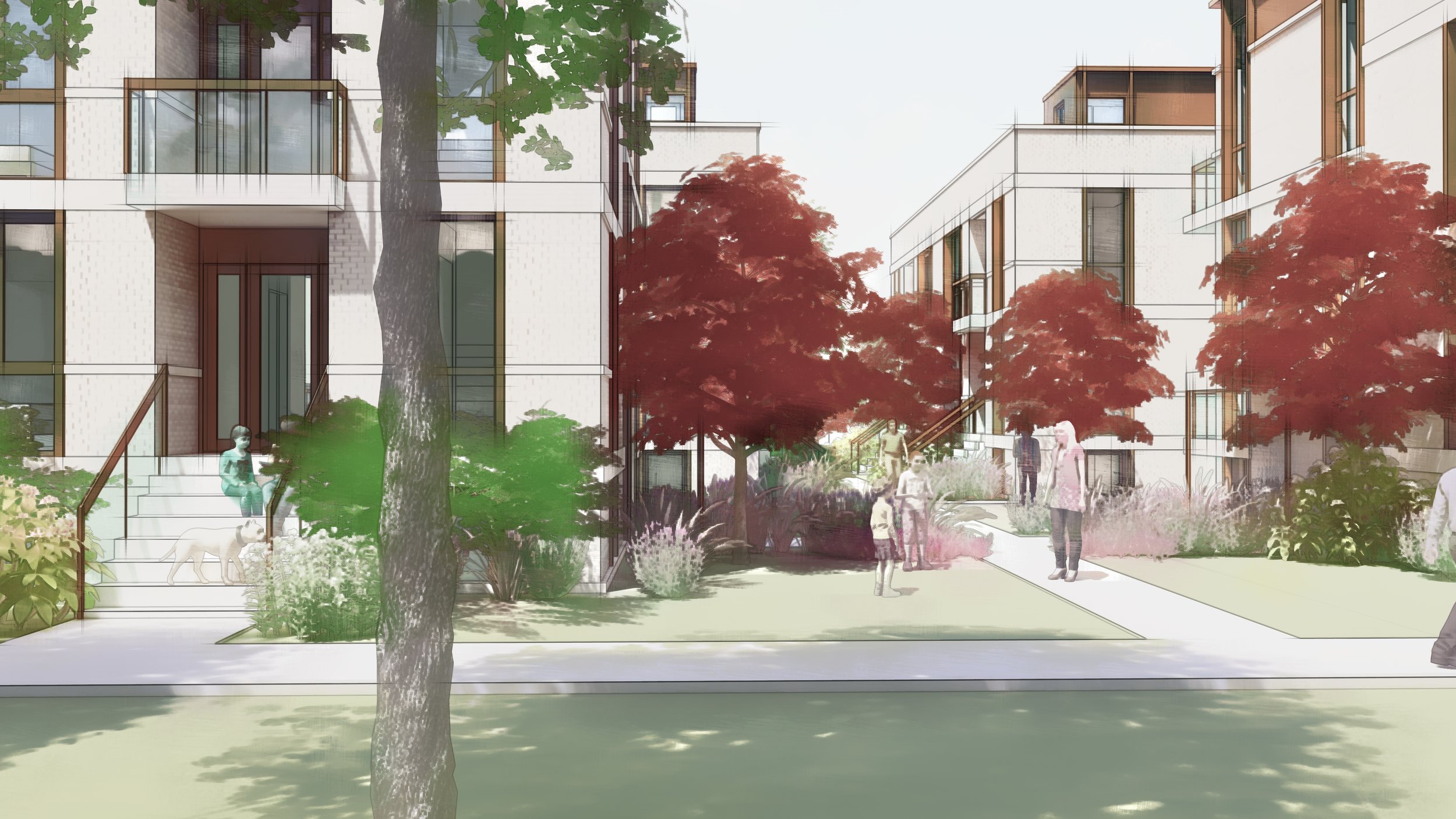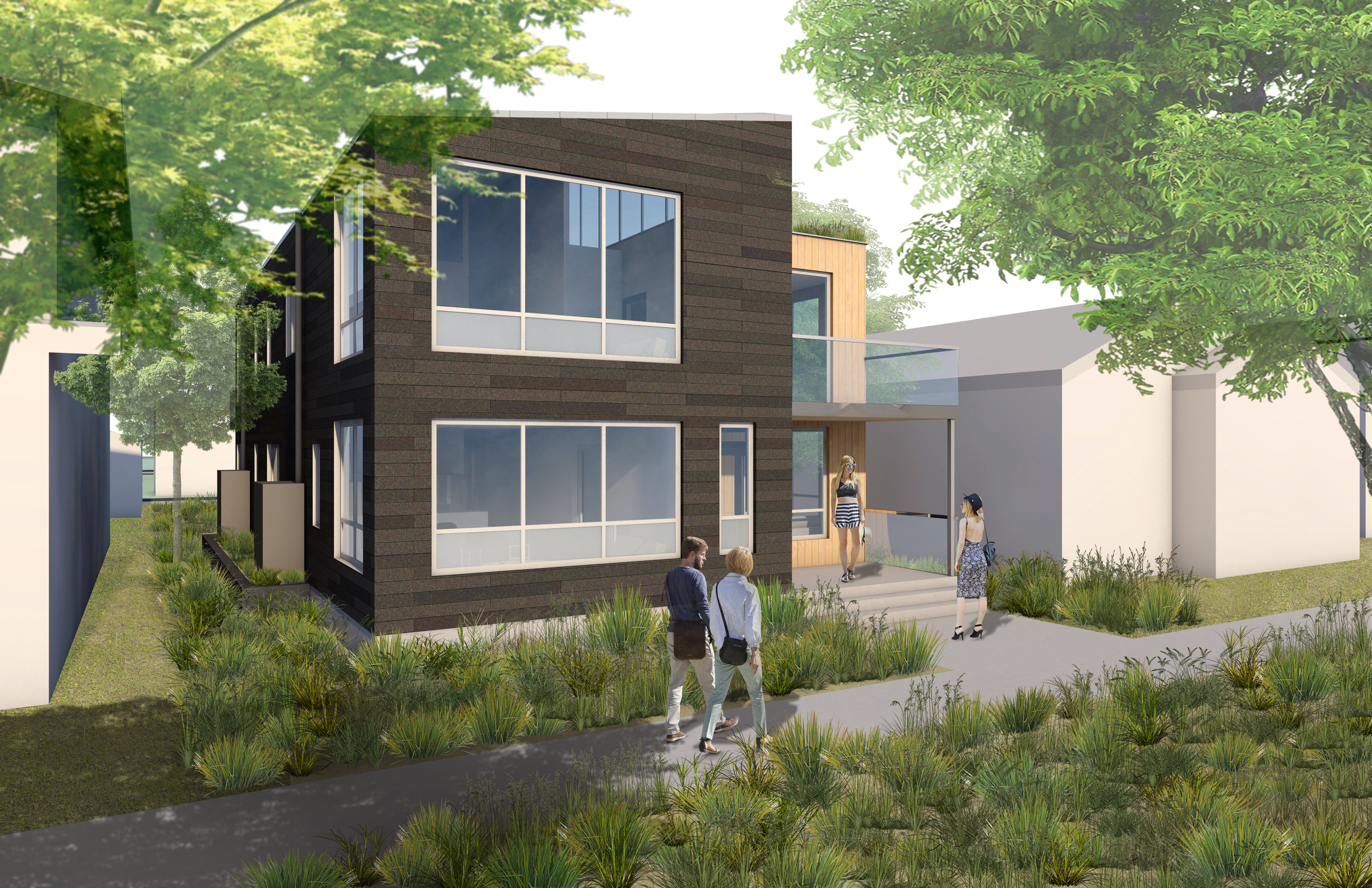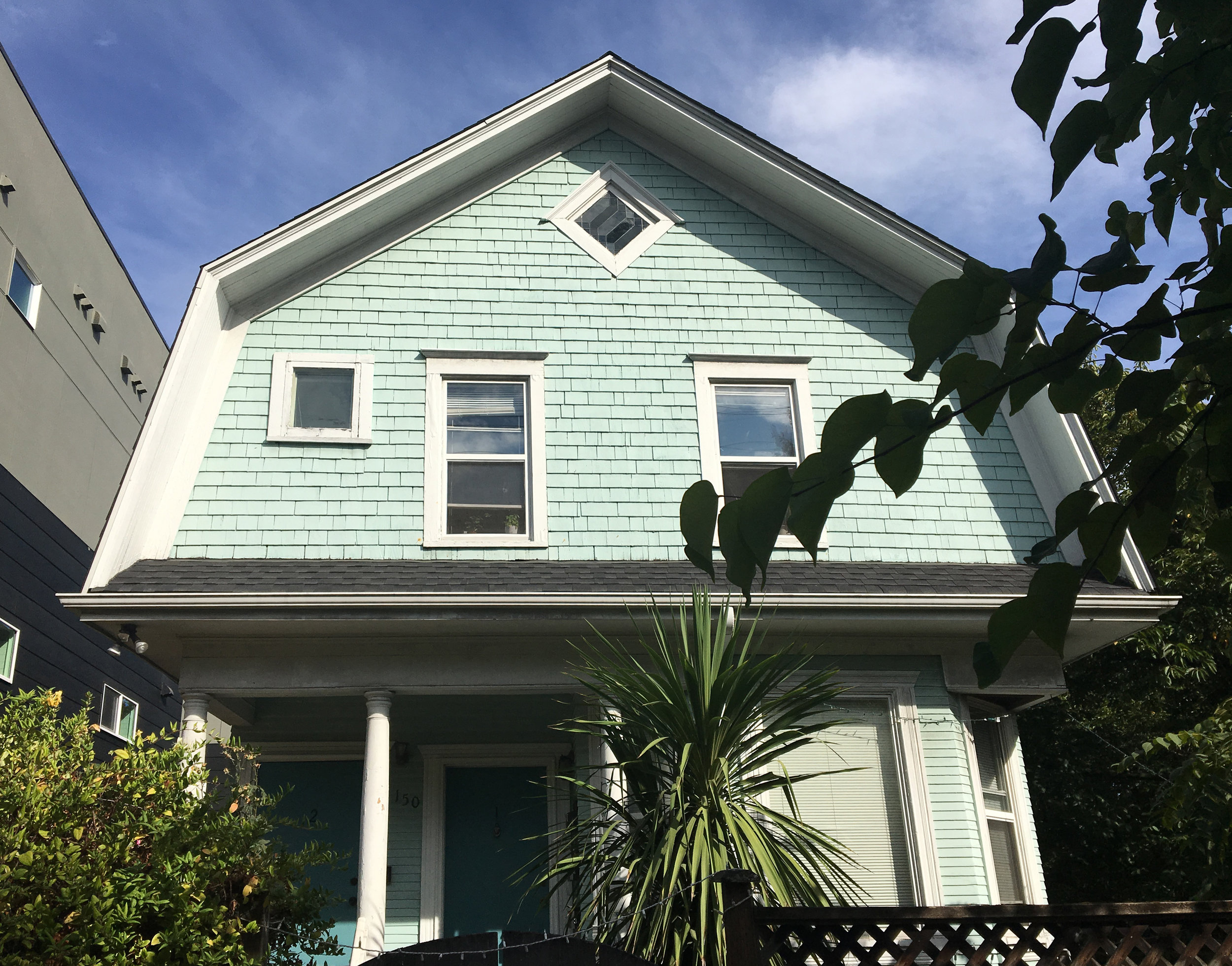Download it here: New Housing Options in Residential Small Lot (RSL) zone.
Residential Small Lot will allow little stacked flats like this. How you use them is up to you!
If you are thinking about downsizing but don’t want to relocate to a new neighborhood, or to a tiny impersonal apartment in a big boxy building, there are very few choices out there.
Luckily, with Seattle’s Residential Small Lot Zoning (RSL), there are some fresh options. CAST architecture has been working with the land use code for about a year, and now that it is approved in many Seattle Urban Villages and Hubs like Crown Hill, West Seattle, Morgan Junction, and Roosevelt, we want to show off some of the possibilities to do density right!
We often lament that there are essentially very few single level living situations that aren’t little condos, and even fewer that have been built this century.
With this ‘Double Up’ Duplex, there are two primary residences, one at ground level, one up. Each primary residence can be configured with an Accessory Dwelling unit. At 2200 square feet per level Including the ADU), that could be a generous home with a built in rental stream. If someone wanted to develop the whole building, it would be perfectly legal to own the entire building, rent one level, and the ADU adjacent. Don’t want to be a landlord? It can be configured as a condo association.
Downsized, accessible, modern, super energy efficient living, with two revenue streams, not to mention a great front porch and big backyard!
On any RSL lot, we can design a two unit flat with accessory dwellings units.
Here is a second story plan, with a primary and accessory unit. could easily be a 3br and studio apartment
We’re excited about what is possible under Residential Small Lot and hope that the best solutions get adopted far and wide!
Residential Small Lot zoning will create new housing options in established urban village neighborhoods
Mandatory Housing Affordability passed City Council yesterday, and as part of that, about 7000 urban Single Family lots will now be able to have two or three primary residences (plus ADUs) on site. I’m pleased that we were able to suggest some amendments that will make the zone more workable, improve flexibility for sites where people would like to preserve the original house.
What is RSL?
In a nutshell:
1 primary residence per 2000 sq ft of lot (one ADU per primary residence allowed)
if your lot is smaller than 4000 sq ft, you could still do two residences.
Floor Area Ratio : .75
Lot coverage: 50%
Maximum size of any single primary residence: 2200sq ft.
Residential Small Lot Streetscape
While conceived as a kind of new ‘cottage’ zoning, it is better suited to compact 2 1/2 story urban houses.
We’ve come up with a prototypical design which maxes out all the limits, and it still feels pretty good within the existing streetscape. It is a 1500 sq ft upper unit, with main level suite, and open living/dining/kitchen (w/ twelve foot ceilings), two typical bedrooms and a second master on level two, with a patio/kitchen garden on the roof. In the basement (half below grade to avoid being counted toward F.A.R.) we’ve designed a 1 bedroom/1 bath Accessory Dwelling Unit, which could easily be integrated into the primary house, set up to generate revenue to help with the mortgage, or be co-owned like a two party condo association.
Because it is a relatively compact volume, with flexibility about solar orientation for a range of urban sites, hopefully we’ll get some owners interested in pursuing Passive House green building standards!
Residential Small Lot zoning: Courtyard bungalows
There is a real opportunity, once you start combining lots, to also aggregate the open space, and get back to that Courtyard Bungalow type that we used to build before zoning made them by and large illegal. Since parking isn’t going to be required for most, the market is going to dictate, but hopefully we’ll be spared a lot of impervious area creating more run off issues.
What is the RSL market and will any of it be affordable?
While I’m pretty excited about the eventual potential of this zone, there are very few neighborhoods where this is going to pencil (i.e. high priced, high demand markets).
1) it is happening where land values are going to be the highest (urban villages), but with the low density limits, land costs cannot be spread across more than 2 or 3 units for the most part—at minimum $300K of any newly developed unit is going to be for land value.
2) With low densities, it will be nearly impossible to provide new rent restricted housing on site. Nearly all development will pay the MHA fee (up to $45,650 per unit). With the ‘downzones’ to RSL that Council enacted with the late amendments taking many Lowrise areas a step back, it ensures than most of those areas will never see rent-restricted housing.
3) Similar to Vancouver’s market where the high cost of detached housing is tempered by ‘mortgage helpers’ like Laneway houses, ADUs are really the only new less expensive option, and that is purely because of the size of those units.
6 Courtyard townhouses on a 12,000 sf ft lot
Seattle is going to change thousands of residential lots from ‘Single Family’ to ‘Residential Small Lot’ (RSL) as part of the MHA zoning reform. The rules covering RSL have been totally rewritten and there are many questions about how it will affect our neighborhoods such as Crown Hill, West Seattle, and South Park
What is RSL?
Where is RSL?
What are the rules governing the density, size, etc?
How is MHA going to factor into development?
What is the difference between a backyard cottage and a second house?
What are some of the prototypical developments that are possible under the new code?
If you live in one of the affected urban village or are interested in innovative infill housing, join Matt Hutchins, AIA for this informational talk.
RSVP here:
RSLZ will allow courtyard walk-ups!
Seattle is going to change thousands of residential lots from ‘Single Family’ to ‘Residential Small Lot’ (RSL) as part of the MHA zoning reform. The rules covering RSL have been totally rewritten and there are many questions about how it will affect our neighborhoods such as Columbia City and Rainier Beach.
First, what is RSL and what kinds of new development are we likely to see?
Second, how does RSL address displacement, affordability, density or sustainability?
Finally, how can we improve RSL so that it can be the most effective before the ordinance comes before Council?
If you live in an urban village or are interested in innovative infill housing, join Matt Hutchins, AIA for this informational talk.
RSVP here:
https://www.eventbrite.com/e/envisioning-seattles-small-lot-zoning-future-tickets-52921269943
Seattle is going to change thousands of residential lots from ‘Single Family’ to ‘Residential Small Lot’ (RSL) as part of the MHA zoning reform. The rules covering RSL have been totally rewritten and there are many questions about how it will affect our neighborhoods such as Columbia City and Rainier Beach.
First, what is RSL and what kinds of new development are we likely to see?
Second, how does RSL address displacement, affordability, density or sustainability?
Finally, how can we improve RSL so that it can be the most effective before the ordinance comes before Council?
If you live in an urban village or are interested in innovative infill housing, join Matt Hutchins, AIA for this informational talk.
RSVP here:
https://www.eventbrite.com/e/envisioning-seattles-residential-small-lot-future-tickets-52921293012
Seattle is going to change thousands of residential lots from ‘Single Family’ to ‘Residential Small Lot’ (RSL) as part of the MHA zoning reform. The rules covering RSL have been totally rewritten and there are many questions about how it will affect our neighborhoods, including most of South Park.
First, what is RSL and what kinds of new development are we likely to see?
Second, how does RSL address displacement, affordability, density or sustainability?
Finally, how can we improve RSL so that it can be the most effective before the ordinance comes before Council?
If you live in an urban village or are interested in innovative infill housing, join Matt Hutchins, AIA for this informational talk: Follow the link below to RSVP. Thanks!
https://www.eventbrite.com/e/envisioning-seattles-residential-small-lot-future-tickets-51155568683
Steelaway Cottage, by CAST architecture 2018
To celebrate the final Environmental Impact Statement that came out last week, we’d like to highlight some of the less obvious but clear reasons for progressive Seattle to embrace the new ordinance covering Accessory Dwellings.
1. Many ADUs end up being affordable, even if they are admittedly expensive to build. I have made the case over and over that we should approach ADUs with our eyes open as to the cost and not put too much faith in them as a cure-all for our housing crisis. But, in surveys collected from Vancouver, Portland, Ashland, Eugene, Edmonton, the Bay Area, a large percentage (generally around 20-25%) of accessory dwellings end up being rented for nothing, very little or well below market rate. Voluntary affordability, where the owner has prioritized the benefit of having family, friends, or even good tenants as neighbors over the potential rent they could demand if they were more ruthless landlords is a major benefit of this form of housing.
Voluntary Affordability in Portland. https://accessorydwellings.org/2014/08/07/do-adus-provide-affordable-housing/
Voluntary Affordability in Edmonton. https://accessorydwellings.org/2017/09/08/garden-suites-in-edmonton-a-private-investment-in-the-public-good/
For example, I have friends who have not raised the rent in 9 years for their upstairs mother-in-law apartment because they love the tenant but she’s on a fixed income. It’s a sweetheart deal they want to last as long as she can handle the stairs. These anecdotes are the rule for homeowners who’ve ‘DIY’ developed an extra unit on their property.
In Portland among owners who live in their ADU, 41% of the primary residences where offered for FREE. Meanwhile, we’re fighting tooth and nail over an inclusionary zoning program that might create 6–10% of new housing as rent restricted. The reality is that a naturally occurring housing type people desperately want to build all over is also 2 1/2 times more likely to create truly affordable housing than our best big policy idea.
2) Making Mother-in-Laws and cottages pencil financially counters wild speculation on McMansions. In the Draft EIS, the City ran different financial models for potential development outcomes. In the draft EIS, 46% of the possible scenarios resulted in tear down/replacement McMansions being the most profitable investment. It was only in cases where the land value was high and the lots were large that adding an ADU and DADU made sense. But if you value the neighborhood and want to curb the momentum of displacement and gentrification, supporting options where a second or third household can add rental income suddenly flips the proforma against the disruptive scourge of McMansions.
3) Renters are Seattle’s majority and any related stigma is out of touch. Owner occupancy restrictions are the biggest impediment to the creation of more housing and keep lower income renters out by limiting the number of options for less expensive dwellings to exist. The checkered history of zoning as a substitute for outlawed racial or class covenants is well documented.
More than 20% of Seattle houses are already rentals. We don’t have a restriction on renting out a detached house and has very few expectations of landlords (more might be in order) yet neighborhoods still thrive. Both tenant and landlord are by and large responsible neighbors. Ask any renter, and they will tell you that they are just as committed as property owners to the neighborhoods, support the local businesses, and participate in civic life. As the majority of Seattleites, renters make up the underlying tax base that funds our government, parks, police, and transit (renters pay property taxes too, just through rent).
4) Besides, owner occupancy restrictions should be illegal. Limiting WHO can use land, as opposed to what the land’s function is isn’t really the job of the land use code. Making property ownership the prerequisite to use is unique to ADUs and has been challenged elsewhere. Other jurisdictions, such as Alberta Canada explicitly allow residency without ownership wherever residences are allowed for that reason.
Find the duplex! (Answer below)
5) Finally, extra dwellings are already everywhere. While people might worry that allowing a ADU and a DADU without owner occupancy restrictions will lead to no less that the ‘destruction of our most unique resource, Seattle’s single family neighborhoods,’ the reality is that there is a long history of small multi-family dwelling coexisting with and even predating the now dominant paradigm of stand alone houses for solitary households. Turn of the last century neighborhoods, like Queen Anne and Wallingford (pictured above), valued for their amenities, walkability, and housing stock, were developed mostly before zoning. They are filled with the highest concentration of small multifamily buildings, house more than 10,000 households, but you might never know it from the street. Honestly that is part of their charm and vitality. If the worst thing is that there are a few more families per street, I think our neighborhoods are more than resilient enough to handle it.
Every dot is at least one extra household that doesn’t need a stand alone house.
*In the photo above every structure is a duplex, triplex or fourplex, with the exception of the tallest white structure on the left.
RSL Walk ups and cottage developments create a neighborhood within a neighborhood.
Seattle is facing a housing shortage, a climate crisis, and an increasingly inequitable city. Allowing more dwelling options, at various sizes and price points, is a great strategy to combat all three. Enter the Residential Small Lot Zone, Seattle’s attempt to add less expensive dwellings in dense, amenity rich urban centers without disrupting the historical fabric of single family detached houses.
As part of Mandatory Housing Affordability (MHA), Seattle is rezoning many of the Urban Village parcels currently zoned ‘Single Family’ to ‘Residential Small Lot‘ (RSL). RSL exists under the code right now, but is applied to only 7 acres of zoned land in Seattle and has narrowly defined housing types and restrictions that have kept it from wider acceptance. Under MHA, RSL will be expanded to 768 acres and include about 6200 Single Family Lots. The proposed code has been rewritten from the ground up, so let’s dig in and see what it is likely to produce for Seattle’s neighborhoods.
Function
Reading the definition of RSL, it is hard not to feel sorry for this hard working zone.
It has to be a little of everything to everyone. It is uncommon for a zone description to get into issues of affordability, children, and the desires of its residents. We don't expect the description of General Industrial 2 (IG2) to make judgments about dockworkers’ life choices. Or Downtown Office Core-1 (DOC-1) to wonder about whether people in Downtown Office Core 2 (DOC-2 ) feel development there is appropriate.
Nevertheless, it exposes a question. What is the mission of RSL? Is it a transition between Residential zones? Is it meant to capitalize on the proximity to urban centers by putting residents close to amenities, jobs and transit? Is it fighting displacement, or fostering density? What need does it serve, and what is the positive vision of that zone? Right now, it is formulated with a little of everything, including some new stuff, and takes elements from single family, multi family, bridges residential and building code with a dash of high minded mission to address family housing and affordability. It is a little like this:
RSL. Not elegant, but adapted to its environment.
The Nitty Gritty: What does it look like on paper?
What does RSL look like?
Before RSL zone, this Single family zoned street has 28 dwellings.
And again, after a generation of development doubles the number of dwellings:
57 dwellings on the street, double the current density, but not much change at street level.
Prototypes for RSL Zoning
We've taken the liberty to suggest some prototypes, based on traditional 'missing middle' multifamily, optimized for this zoning.
Bungalow Court (or the Walk Up Model)
For lots greater than 11,699 sq.ft, this bungalow court has (6) 3BR 1466 sq.ft. primary units, and (6) 733 sq.ft. 1 or 2BR ADUs. This walk up is really a module that can be arranged into twos, threes, any grouping based on density limitations.
Double Up Duplex
Our idea is for a stacked duplex, 1500 sq.ft. configured for an ADU, optimized for the allowable FAR on a minimum 4000 sq.ft. lot. We'd target Passivhaus green building standard, integrate green roof, pv, and rainwater catchment.
Alternative configurations for ADUs, or future co-housing options.
Recommendations for code tweaks!
Here are fourteen ways we can improve the Seattle’s MHA’s totally rewritten Residential Small Lot zone, BEFORE it goes into effect:
1.Exempt RSL from MHA fees. New dwellings created in the RSL zone will be subject to MHA, but will anyone built a rent restricted house? No. Therefore, fees due at permit issuance could be as high as $45,650. It will have a dampening effect on any homeowner looking to build a second house on the back of their lot. Many of those homeowners will build an ADU instead (not subject to MHA fee), eliminating the upside of more smaller homes in the marketplace.
2. Allow ADUs to function as MHA performance! MHA performance is 50% for lots under 5699 sq. ft.. Meanwhile ADUs are by definition limited to a smaller size, and making them affordable would be closer in spirit to the original intent of the ordinance.
3. Eliminate new Maximum Net Unit Area limit. Maximum Net Unit Area is a new, unique limitation that only applies to this zone, and nowhere else. It is Floor Area per Unit, and it is often in conflict with the Floor Area Ratio (FAR) for the parcel. There are no MNUA exceptions for existing houses or additions, meaning many of Seattle’s classic bungalows in RSL zones will suddenly become non-conforming, unable to do a ‘bump out’ or even a SECOND story addition. Because basements count toward MNUA, but not FAR, expect a lot of new buildings with basements apartments.
A basic RSL block reveals surprising inflexibility unless you want to add a second dwelling
The owners could only do a 230 sq. ft. addition. Not a second story. They could however build a new dwelling behind it up to 2200 sq. ft.
4. Start FAR at 1, give .25 bonus for more dwellings. The FAR is .75, lower than any Low Rise zone, and effectively lower than Single Family zoning (only governed by height and lot coverage). If RSL is meant as a transition between multifamily and single family, it is more restrictive that both.
5. Lower the density ratio to 1 to 1500. Fourteen percent of the newly minted RSL lots will not even support a second dwelling. Why go through this process then wipe the development capacity of 900 lots off the table? Rounding up for density at 1.85 * 2000SF means any lot under 3699SF is still a single family lot, but MNUA effectively limits all dwellings to an FAR as low as of .59.
6. Allow more than one Accessory Dwelling Unit (ADU). All these lots are in urban centers, where we are planning to put almost all our growing population. Many lots or owners aren’t going to want to built a full second dwelling. Meanwhile, SFZ will soon allow two ADUs per primary residence. This flexibility will preserve many existing houses, and provide homes for new residents right in the urban villages.
7. Exclude ADUs from MNUA. An accessory dwelling unit counts against the MNUA, meaning many average houses wouldn’t be able to build a cottage without sacrificing square footage in the primary house.
8. Resist the urge to Design Standard. The two Design Standards for RSL are ridiculous. Different color walkways to the house in back? Why? We don’t expect such ham fisted wayfinding in multifamily zones where there’s likely more front doors. One of the great strengths of the proposed code is that it did away with the many of the restrictive types, like ‘tandem housing.’ Let’s not dilute it with well meaning micro management, only to find out that we’ve created a less than graceful solution (remember the platypus!).
9. Allow exceptions from MHA when preserving existing houses. Subdividing existing houses into multiple units will be penalized by the Design Standards, and be subject MHA fee, at the full price for the area of units. The MHA fee calculation is gloss floor area/total units X net increase of units. A 3000 sq ft house, converted into a triplex from single family, would pay MHA on 2000 sq ft as if new, or up to $41,000. That neither incentivizes preservation or the creation of more affordable housing.
This is a triplex. Converting it under the MHA regime would cost tens of thousands of dollars in MHA fees in addition to the requirements of retrofitting.
10.Take out limit on number of apartments. The stigma of apartment living results in one of the most efficient (and revered) forms being outlawed. The code is clear: RSL outright outlaws more than three apartments regardless of lot size. No cute Capitol Hill fourplexes.
This fourplex is not allowed under the new RSL zone.
11. Eliminate owner occupancy requirements. We don’t require owners to live on site in other multifamily zones, owner occupancy requirements will severely limit the number of accessory dwelling units and they reinforce a fundamentally class based stigma against renters.
12. Change all residential zones to ‘Residential’. We now have three titles for zones where residences are the only use; Single Family, Lowrise, Residential Small Lot. While RSL is being treated as a unique bridge between SFZ and LRZ, it should be part of a continuum of dwelling per square foot. Streamline!
13. Amend Seattle Residential Code to cover up to four apartments. Building codes switch to the more demanding SBC for anything more dense than a duplex and ADUs are considered as such. When buildings should be getting more efficient, like stacking a third apartment on top of a double decker, there is a quantum leap in construction cost, driven by code compliance.
14. Allow Live Work and Corner stores. In midrise zones, having residential suites at the street level seems forced. Two blocks from the center of an urban village, having an office space legible from the street makes total sense. Allowing corner stores would expand the walkshed so more people will walk to pick something up, rather than drive to a supermarket.
Neighborhood institutions start with entrepreneurial neighbors. Give them a place.
How the Code currently allows a bigger house than any conceivable house plus DADU option
Will Seattle’s move to make more Backyard Cottages lead to a more sustainable city or just amplify environmental impacts?
You might think that more DADUs would lead to more environmental impacts—after all, construction takes fantastic amounts of resources (including capital). Being in the backyard, DADUs should increase of impervious area, lead to the loss of tree canopy, compound parking conflicts, and stretch City services even thinner, right? Isn’t the shadow of neighbor’s potential cottage going to forever keep me from growing the perfect heirloom tomato?
Last month, Marty Kaplan, under the aegis of the Queen Anne Community Council QACC, appealed a SEPA Determination of Non-Significance (DNS) with regard to changing certain characteristics of the Accessory Dwelling code.
Right off the bat, it is important to clarify that a DNS doesn’t state that there will be zero environmental impact, but as city wide code, it is impossible to evaluate impact on each individual lot without a real project associated with the lot. This is a ‘Non-Project Action.” While you may be affected by something built next door, until there is a project conceived there, the City has no method to evaluate its environmental impact. In fact, the original backyard cottage ordinance was given a DNS, an inconvenient fact not lost on the Kaplan, since he helped craft it while on the Planning Commission.
Today I finished testifying on behalf of the City on the Appeal, to establish a plain truth: Even if the City could evaluate the site by site impacts, they would show the City allows any single house to be much larger than any combination of house + DADU. Additional DADUs or larger DADUs are a reduction of environmental impact in comparison.
Furthermore, the number of people allowed to live there stays the same (8 people per lot), although more of them would be new renters much to QACC’s dismay. Energy code, tree protections, stormwater code, etc all stay the same under the new code. The impervious area actually goes down--by eliminating the parking requirement. How can there be significant environmental impacts, if the rest of the code is identical and the only difference is the number of families (not people allowed) per lot?
The SF zone is a zero sum environment—there is only so much buildable area, and if you choose to build a cottage, its lot coverage must deduct from the maximum size of the main house. And because it can’t be as tall, there is less available volume. It is a prima facia case, and in my mind, underlines the DNS.
As a proxy for all the land use regulations, we created a schematic diagram to illustrate the potential buildable envelop as a single family house, house with an accessory structure, and a house with a DADU. We repeated the diagram under the new ordinance. In all cases, the biggest volume was the solitary single family McMansion allowed by right today.
You only need to walk by a tear down house replacement and a backyard cottage to understand how the argument about which is better per QACC’s concern about neighborhood character is inverted. The QACC’s exhibits inadvertently made this exact point by showing an entire street of adorable bungalows replaced en masse with windowless 35’ blocks, completely obscuring whatever cottages in the backyard.
Which is where the tomatoes come in the picture. One witness testified that if the ordinance goes through, and cottages were built on all sides of his small lot (possible, but very, very improbable), there wouldn’t be any sunlight left for his tomatoes. He should be all for the new code—every new cottage built is a hedge against a speculative developer tearing down the old bungalow and putting up a maxed out single family house. And that which would really put his garden in the shade.





